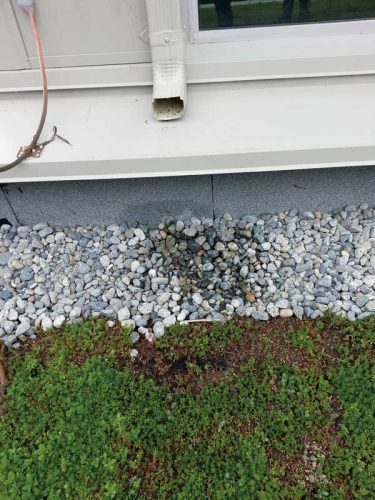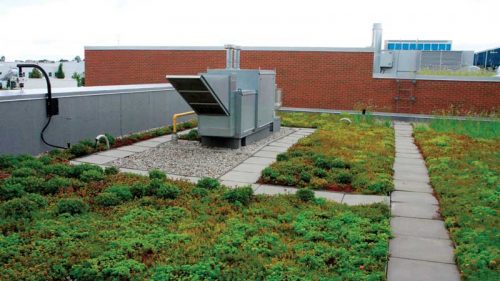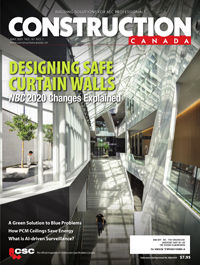Designing extensive and semi-extensive vegetated roofs for long-term performance

Photo courtesy Xeroflor Canada/Sasha Aguilera
Design for special problem areas
Roofs offer a harsh environment for plants, with vegetation often completely exposed to the elements with minimal protection from drying winds and intense sun. Further, plant survivability can be challenged by hidden stressors inadvertently designed on a roof. Generally, it is recommended to set back the vegetation from potentially damaging areas and in its place, create a ‘vegetation-free zone,’ traditionally comprising patio slabs or aggregates of 300 to 600 mm (12 to 24 in.).
Vents and water runoff
Direct exposure to air vents, whether warm or cool air, quickly dries out vegetation. Water travels through a plant’s stem to its leaves for critical life processes. Without adequate moisture levels in the plant’s foliage, its survival will be greatly challenged. At the same time, too much water can prohibit plant growth. While ponding water is obviously damaging to most green roof plants, water that drips or lands forcefully on the vegetation is also detrimental. Water rushing forcefully out of downspouts or consistently dripping off a higher rooftop will cause plant damage. Eventually, growing medium will be eroded, creating an environment impossible for thriving plants. Such areas should be vegetation-free zones and wide enough to bear the drying effects of vents or damage from direct water runoff.
Reflected light
Most plants grow best in full sunlight, but, again, too much of a good thing can prove harmful. In the case of vegetated roofs, an additional concern is intense sunlight in the form of reflected light. A glass curtain wall can reflect almost all the sunlight hitting it onto the vegetated surface at its base. This reflected light can cause growing medium to lose moisture, stunt plant growth, and cause a yellow-white ‘burn’ on the surface of foliage. To prevent plant injury from extreme levels of intense sunlight, particularly common along southern and western glass curtain walls, a generous vegetation-free zone should be provided.
Full shade
The vast majority of recommended green roof plants are sun-loving because, after all, roofs can be extremely hot with little respite from the sun. However, cities are becoming increasingly dense and have nowhere to go but up, leading to taller and taller buildings that may cast dark imprints not only on the streets below, but also on neighbouring rooftops. In such cases, a summer shadow study is useful to help determine whether the sun-loving plant list should be exchanged for a shade-tolerant one.
How many hours of direct sunlight are the minimum requirement for most sun-loving vegetated roof plants? Anything less than four hours necessitates shade-tolerant species, which typically have higher water and deeper-growing media requirements than the traditional list of sun-loving, drought-tolerant, vegetated roof plants. In their natural environment, shade-loving plants enjoy protection from the sun, reduced evapotranspiration rates, and higher soil moisture levels. A shady rooftop only meets one of the conditions for them to thrive.
Watering requirements are equally important. A generous and reliable watering regime needs to be provided by a permanent irrigation system on shady roofs. Shady and moist roof areas can become less-optimal environments for plant growth when air stagnates. It may seem impossible to have inadequate airflow on a vegetated roof because of its higher elevation, but lack of good circulation can be a concern at any height. This is especially true in cornered locations with constricted air movement. Stagnant air can promote foliar fungal diseases and other plant health problems.

Photos courtesy Liveroof
Vegetated roof system details
Vegetation should be kept a safe distance away from any roof penetrations, in particular roof drains. Vegetation coverage, loose growing medium, or aggregates can obstruct the drain resulting in ponding water—this is not only detrimental to the health of green roof plants, but also, more critically, the building’s structural integrity.
As a general recommendation, vegetation-free zones should be maintained around all roof details, such as pipes, roof anchors, gas lines, and any other element that may require future inspection, maintenance, and repair. Distancing plants from these details not only protects them from disturbance during a repair, but it also allows for a more straightforward repair.
Lightning protection systems can pose challenges, for example. Flexible vegetated roof products can be draped over the systems, while more rigid vegetated roof products may require a level base, forcing the lighting protection assembly layout to be designed accordingly. If vegetation coverage must be designed in areas prone to disturbance, then it might be wise to choose a vegetated roof system that is simple to remove and reuse, as this could diminish the cost and time involved in repair work. An effective vegetated roof layout does not simply consider the esthetic function; rather, it considers the practical limits of the plants as well as the roof assembly itself.
Ensure high quality—in the bidding and in the awarding of projects
Vegetated roofs can be specified in several different ways based on the design parameters mentioned earlier in the article. Whether the consultant specifies with a pure performance specification, a basis of design (BOD) with named products, or a single-source specification, it is important bidders abide by the specifications and the rules for requesting alternates and substitutions as set out in the bid documents (i.e. Division 01). As mentioned earlier, it is possible to achieve the same goals in a number of different ways with a living building product such as a vegetated roof. However, since the consultant has written the specifications and prepared the drawings based on the goals on which the client and design team have agreed, it should be incumbent on the proponents of alternate systems to prove they can meet or exceed the design team’s objectives.
The authors have seen numerous occasions where either clients did not receive the product they had expected, or where contractors were in difficult situations because they carried a non-approved product in their bid. Neither situation is pleasant for the client, the consultant, or the contractor. Reading and understanding the relevant bid documents (i.e. 01 33 00−Submittal Procedures, as well as 07 33 63−Vegetated Roofing) is crucial to successful bidding and execution of projects.
Various vegetated roofing manufacturers insist contractors be licensed and approved before they are allowed to bid and install their systems. While not an absolute guarantee the subcontractor has carried an approved product, it is nonetheless a safeguard for general contractors and roofing or landscape contractors. It enables them to request a current licensing certificate from the bidding vegetated roofing subcontractor, along with a declaration it carries either an approved product or one meeting the requirements of the bid documents.
Since the short window in which bid closings happen can often be chaotic, it is usually best to carry the bids of a trusted subcontractor rather than the last-minute low bidder. Value engineering without consideration for the multiple factors going into the design and specification of a particular vegetated roofing system can lead to unexpected performance and maintenance issues.


